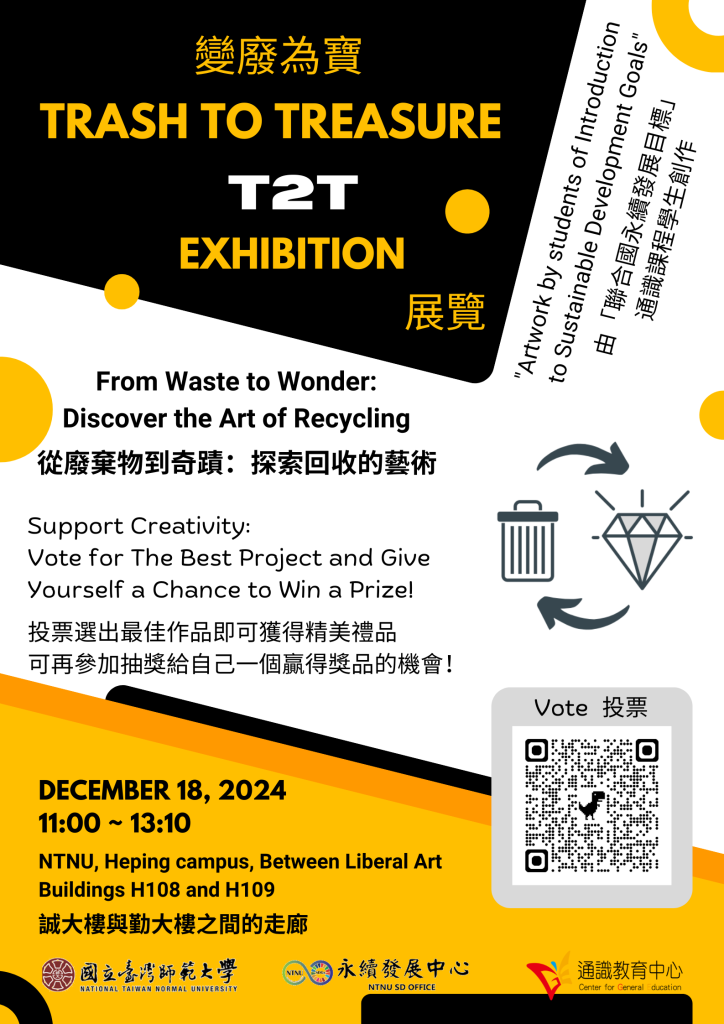✨TRASH TO TREASURE EXHIBITION – From Waste to Wonder: Discover the Art of Recycling✨
On December 18, students from the “Introduction to Sustainable Development Goals” course, taught by Professor Hoda Fakour, showcased their semester projects in a special exhibition titled “Trash to Treasure.” Organized in collaboration with NTNU Sustainable Development Office and Center for General Education, the event highlighted innovative and functional creations made from at least five recyclable or discarded materials. The exhibition celebrated the integration of creative design with environmental consciousness, embodying the principles of sustainable development. It also aligned with Sustainable Development Goal 12 (SDG 12), which emphasizes waste reduction through prevention, reduction, recycling, and reuse, and Sustainable Development Goal 13 (SDG 13), which focuses on climate action.
The exhibition featured 14 creative projects, with each student team utilizing items they had used daily, integrating personal emotions and memories. Using discarded materials such as old exam papers, plastic bottles, newspapers, juice and milk cartons, and cardboard boxes, the students crafted a variety of works, including the “Environmentally Friendly Vintage Pinball Machine,” “Animal Box (Elephant),” and “Upcycle of Bicycle Wheel.” Some creations served as decorative or storage solutions, while others offered interactive experiences that visitors could enjoy on-site, making the event both meaningful and entertaining.
A voting activity allowed attendees to support their favorite works, and participants who completed a sustainability literacy survey received a small gift. The event attracted over 200 visitors, who provided enthusiastic feedback such as “meaningful,” “amazing,” and “hope to see this again.” Professor Chang, Director of the NTNU Sustainable Development Office, and Professor Yang, Deputy Controller of the TVBS News Department, attended the exhibition to show their support. Alongside the course instructor, Professor Hoda Fakour, they engaged in discussions on sustainability topics and interacted with the showcased projects.
After the voting process, “ECO GACHA” and “Eco-friendly Snoopy House (drawer)” emerged as the top two crowd favorites. “ECO GACHA” cleverly combines the concepts of a capsule toy machine and a fortune cookie. Visitors could turn the machine handle, releasing a fortune from recycled paper. Each fortune carried an inspiring environmental message: “The clean air you breathe is nature’s gratitude for your stewardship.” After drawing their fortune, participants were invited to sign their names on the machine to leave their mark. “Eco-friendly Snoopy House (drawer)” is a functional and charming drawer made entirely from eco-friendly materials. Designed with sustainability, it balances practicality and aesthetic appeal. If the drawer becomes damaged or unusable, it can be disassembled and recycled, exemplifying the principles of a circular economy.
The “Trash to Treasure” exhibition showcased the students’ creativity and practical skills and demonstrated the potential of resource recycling and innovative design. Students successfully transformed discarded materials into functional and aesthetically pleasing creations through their efforts. This general education course emphasis on the United Nations Sustainable Development Goals (SDGs) was brought to life through the public exhibition of student projects. The event empowered students with the skills and motivation to take action toward campus sustainability and heightened awareness of resource sustainability among faculty and students. Furthermore, it inspired a broader audience to join the movement for environmental protection.







